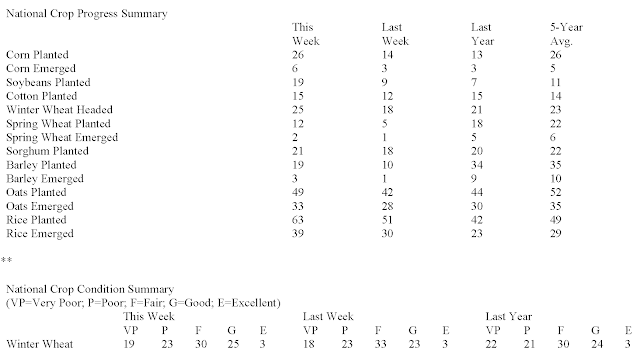OMAHA (DTN) -- Corn and soybean planting progress moved ahead by double digits last week, and winter wheat conditions edged slightly higher nationwide thanks to much-needed rain across parts of the Southern Plains, USDA NASS reported in its weekly Crop Progress Report on Monday.
CORN
-- Planting progress: Nationwide, corn planting moved ahead 12 percentage points last week to reach 26% as of Sunday, April 30. That is 13 percentage points ahead of last year's 13% but equal to the five-year average. Notable states: Iowa was 29% planted, and Illinois was 40% planted, well ahead of the usual pace for Illinois, according to DTN Lead Analyst Todd Hultman. Missouri is nearly done at 80% planted. Meanwhile, Northern states continue to struggle, with no planting recorded in North Dakota yet, he said.
-- Crop progress: 6% of corn had emerged as of Sunday, up just 3 percentage points from the previous week and just 1 percentage point ahead of the average of 5%.
SOYBEANS
-- Planting progress: Soybean planting moved ahead 10 percentage points last week to reach 19% as of Sunday, 12 percentage points ahead of last year's 7% and 8 points ahead of the five-year average of 11%. Notable states: Illinois is 39% planted, and Iowa is at 16%, near its average pace. The Dakotas have yet to get on the board, and Minnesota is only 1% planted, Hultman noted.
WINTER WHEAT
-- Crop condition: Nationwide, winter wheat was rated 28% good to excellent, up 2 percentage points from 26% the previous week and 1 percentage point of last year's rating of 27% good to excellent. "The poor to very poor rating increased 1 percentage point to 42%, as last week's rains could only do so much," Hultman said. "In Kansas, 64% of the crop was rated poor to very poor."
-- Crop development: 25% of winter wheat was headed nationwide as of Sunday, up 7 percentage points from the previous week and 2 percentage points ahead of the five-year average of 23%.
SPRING WHEAT
-- Planting progress: 12% of the spring wheat crop was planted as of Sunday, up 7 percentage points from the previous week but 10 percentage points behind the five-year average of 22%. Notable states: North Dakota was 6% planted, and Minnesota showed no progress yet, Hultman noted.
-- Crop progress: 2% of spring wheat was emerged as of Sunday, up just 1 percentage point from the previous week and 4 percentage points behind the five-year average of 6%.
THE WEEK AHEAD IN WEATHER
Following a few weeks of below-normal temperatures, farmers in most parts of the country should see a warm-up later this week, according to DTN Ag Meteorologist John Baranick. That will be accompanied by scattered showers.
"Scattered showers are falling near the Great Lakes thanks to a strong storm system that will only slowly spin off to the east over the next few days," Baranick said. "Though below normal early this week, temperatures will be on a rising trend for the rest of the week, starting in the west and gradually following in the east by later in the week. The higher temperatures are expected to get planters rolling as long as soils are not too wet. That includes areas of the Northern Plains that have only recently been able to melt off the last of their snow piles.
"With an upper-level low spinning in the Southwest, scattered showers will fall across western areas of the country for most of the week. It will also get showers to start up in the Plains as well, first starting in the southwest on Tuesday and spreading from there for the rest of the week. A system will then move from the West and through the Plains and Midwest late week into early next week. For an area that got some heavy rain last week, more showers appear to be on the way, though they are likely to be scattered and not hit all spots. Still, additional showers will help to at least limit the impact of the ongoing drought and aid in germination of newly planted crops."





.png)

No comments:
Post a Comment